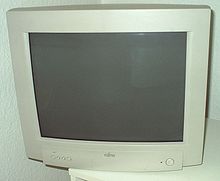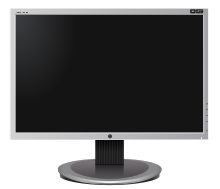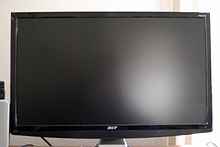- Display aspect ratio
-
The Aspect ratio of a display is the fractional relation of the width of the display area compared to its height.
The aspect ratio is expressed as two numbers separated by a colon. That is, for an x:y aspect ratio, no matter how big or small the display is, if the width is divided into x units of equal length and the height is measured using this same length unit, the height will be measured to be y units.
Contents
Computer displays
Computer displays with aspect ratios wider than 4:3 are also called widescreen. Widescreen computer displays are typically of the 16:9 or 16:10 aspect ratio. Widescreen (16:9) monitors can be found in resolutions of 1024x576, 1152x648, 1280x720, 1366x780, 1600x900, 1920x1080, 2560x1440 and 3840x2160. Apple's 27" iMac introduced the 16:9 resolution: 2560x1440 in late 2009. Widescreen monitors are since 2008 the mainstream standard for computer displays.
History
4:3 and 16:10
Until about 2003, most computer monitors had a 4:3 aspect ratio and some had 5:4. Between 2003 and 2006, monitors with 16:9 and mostly 16:10 (8:5) aspect ratios became commonly available, first in laptops and later also in standalone monitors. Reasons for this transition was productive uses for such monitors, i.e. besides widescreen movie viewing and computer game play, are the word processor display of two standard letter pages side by side, as well as CAD displays of large-size drawings and CAD application menus at the same time.[1][2] 2008 16:10 became the most common sold aspect ratio for LCD monitors and the same year 16:10 was the mainstream standard for laptops and notebooks.[3][4][5]
16:9
In 2008 the computer industry started to move over from 16:10 to 16:9. According to a report by displaysearch the reasons for this were/are:[6][7]
- Innovative product concepts drives a new product cycle and stimulating the growth of the notebook PC and LCD monitor market.
- 16:9 provides better economic cut (panelization) in existing TFT LCD fabs.
- 16:9 products provide higher resolution and wider aspect ratio.[8]
- The widespread adoption of High Definition in the consumer entertainment sector will help end users readily adopt the new products with the wider aspect ratio.
- The 16:9 panels provide an opportunity for PC brands to further diversify their products.
By 2010, virtually all computer monitor and laptop manufacturers had also moved to the 16:9 aspect ratio, and the availability of 16:10 aspect ratio in mass market computer monitors and laptop products had become very limited.
In 2011 Non-widescreen displays with 4:3 aspect ratios still were being manufactured, but in small quantities. The reasons for this was according to Samsung that the “Demand for the old 'Square monitors' has decreased rapidly over the last couple of years,” and “I predict that by the end of 2011, production on all 4:3 or similar panels will be halted due to a lack of demand.”[9]
In March 2011 the 16:9 resolution 1920x1080 became the most common used resolution among users of Steam. The earlier most common resolution was 1680x1050 (16:10).[10]
1.90:1
In the summer of 2011 Eizo presented a new 36.4 inch computer monitor with the resolution 4096x2160 and the wider aspect ratio of 1.90:1. There are rumours that 16:9 eventually will be replaced by 1.90:1 as the mainstream standard for computer displays.[11]
Suitability for applications
Games
Modern games are mainly made for the aspect ratio 16:9 and 16:9 monitors also offer the best compatibility.[12][13] In the majority of games since 2005 one can set the field of view. Some games after 2008 are letterboxed with a 16:10 or 4:3 display.[14][15] 4:3 monitors have the best compatibility with games prior to 2005.[16]
Movies
Movies usually are in 2.39:1, 16:9 or 1.85:1. 16:9 monitors have the best compatibility.
TV/DVD
Since many modern DVDs and TV shows are in 16:9 (1.77:1) or 1.85:1 format, 16:9 displays are optimal for their playback on a computer. 16:9 material on a 16:10 display will be letterboxed. In data processing or viewing 4:3 entertainment material such as older films and digital photographs, the widescreen will be letterboxed.[17]
Windows 8
Windows 8 will run optimal on monitors with the aspect ratio of 16:9 to show off its new user interface. For people using older 4:3 displays, Windows 8 will show an old standard desktop.[18]
Diagonal and area
When displays are marketed the quoted size usually is the diagonal measurement of the display area. Because of the different ratio, a 16:9 monitor will have a smaller area than a 4:3 monitor of the same advertised size.
Comparison between monitors with a diagonal of 23 inches.[19]
Monitor Image Dimensions Display Area Image Area 4:3 content Image Area 16:9 content Image Area 2.35:1 content 23" 4:3 18.4" x 13.8" 254.0 sq. in. 254.0 sq. in. 189.9 sq. in. 143.7 sq. in. 23" 16:10 19.5" x 12.2" 237.7 sq. in. 197.6 sq. in. 213.7 sq. in. 161.6 sq. in. 23" 16:9 20.1" x 11.3" 226.0 sq. in. 168.9 sq. in. 226.0 sq. in. 171.2 sq. in. See also
- Computer monitor
- Display resolution
- Field of view in video games
references
- ^ NEMATech Computer Display Standards http://www.millertech.com/Technical_Specs.htm
- ^ "Introduction--Monitor Technology Guide". necdisplay.com. Archived from the original on 2007-03-15. http://web.archive.org/web/20070315085244/http://www.necdisplay.com/support/css/monitortechguide/index05.htm. (currently offline)
- ^ http://lowendmac.com/musings/08mm/10-percent-notebook.html
- ^ http://www.displaysearch.com/cps/rde/xchg/SID-0A424DE8-28DF6E59/displaysearch/hs.xsl/070108_16by9_PR.asp
- ^ http://www.engadget.com/2008/07/02/widescreen-lcds-going-widescreen-by-2010/
- ^ http://www.displaysearch.com/cps/rde/xchg/SID-0A424DE8-28DF6E59/displaysearch/hs.xsl/070108_16by9_PR.asp
- ^ http://www.engadget.com/2008/07/02/widescreen-lcds-going-widescreen-by-2010/
- ^ Displaysearch: "16:9 products provide higher resolution and wider aspect ratio." http://www.displaysearch.com/cps/rde/xchg/SID-0A424DE8-28DF6E59/displaysearch/hs.xsl/070108_16by9_PR.asp
- ^ http://mybroadband.co.za/news/hardware/17621-Widescreen-monitors-Where-did-1920x1200.html
- ^ http://store.steampowered.com/hwsurvey
- ^ http://www.theinquirer.net/inquirer/news/1031541/1080p-history-industry-4096x2160
- ^ http://ve3d.ign.com/articles/news/59895/The-Witcher-2-Updated-FAQ
- ^ http://www.widescreengamingforum.com/
- ^ http://www.gamefaqs.com/boards/941949-mirrors-edge/47658087
- ^ http://www.widescreengamingforum.com/wiki/Essential_Games_List
- ^ http://www.widescreengamingforum.com/wiki/Essential_Games_List
- ^ Productivity, Screens and Aspect Ratio
- ^ http://www.infopackets.com/news/business/microsoft/2011/20110603_microsoft_demos_windows_8_at_first_public_event.htm
- ^ http://tvcalculator.com/
Categories:- Ratios
Wikimedia Foundation. 2010.




